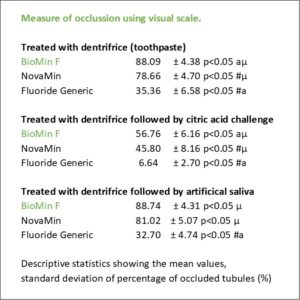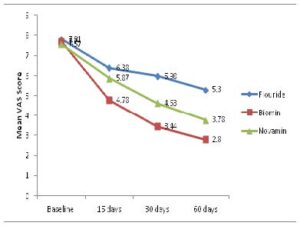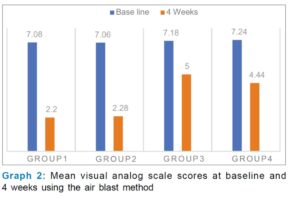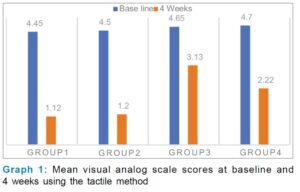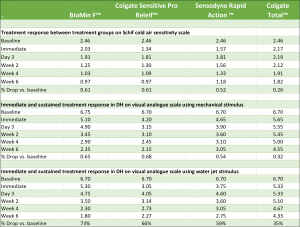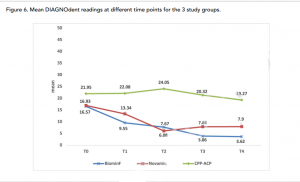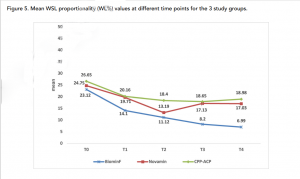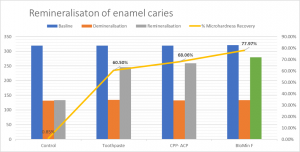Clinical Papers
Reducing Sensitivity / Dentine Hypersensitivity
Comparative Evaluation of Desensitizing Dentifrices containing BioMin®, Novamin® and Fluoride on Dentinal Tubule Occlusion before and after a Citric Acid Challenge
The % of occluded tubles (cause of sensitivity) with BioMin® containing dentifrice (toothpaste) was significantly higher than NovaMin® and a control i.e., fluoride containing dentifrice. Biomin ® and Novamin® containing dentifrices showed significant citric acid resistance compared to the fluoride containing dentifrice although the BioMin® containing dentifrice significantly showed better resistance to a citric acid challenge than the NovaMin® containing dentifrice.
In Australia NovaMin® is registered to GlaxoSmithKlein.
Evaluation of Bioactive Glass Treatment for Dentin Hypersensitivity: A Systematic Review
The calcium sodium phosphosilicate group (CSPS) was not significantly different from the positive control groups. Compared with the control groups, fluoro calcium phosphosilicate (FCPS) may be the most effective long-term treatment option. In terms of DH symptom reduction, the FCPS group performed better than the CSPS group.
Comparative Evaluation of Desensitizing Efficacy of Dentifrice Containing 5% Fluoro Calcium Phosphosilicate Versus 5% Calcium Sodium Phosphosilicate: A Randomized Controlled Clinical Trial
The fluoro calcium phosphosilicate group (BioMin® F) showed a higher degree of effectiveness in reducing DH (Dentine Hypersensitivity), followed by calcium sodium phosphosilicate (NovaMin® ) then standard fluoride dentifrices (toothpastes).
Clinical comparison of 5% fluoro calcium phosphosilicate (BioMin® F) versus 5% calcium sodium phosphosilicate (NovaMin®) in the treatment of dentinal hypersensitivity.
A Randomised Clinical Trial on the Efficacy of 5% Fluoro calcium Phosphosilicate-Containing Novel Bioactive Glass Toothpaste
The toothpaste containing 5% fluoro calcium phosphosilicate (BioMin F) was reported to be more efficacious than the other two toothpastes (B, 8% arginine and calcium carbonate, fluoride placebo) in managing DH. This novel development opens up a unique opportunity in the prevention and management of DH and may also be beneficial in preventing acid erosion of the tooth surface and in the maintenance of oral hygiene by reducing the effects of plaque accumulation and gingival inflammation.
Comparative assessment of effectiveness of Biomin, NovaMin, herbal, and potassium nitrate desensitizing agents in the treatment of hypersensitive teeth: A clinical study
The Biomin® group showed significantly better results compared with either NovaMin®, herbal, and potassium nitrate toothpastes in the treatment of dental hypersensitivity symptoms.
Comparative efficacy of BioMin-F, Colgate Sensitive Pro-relief and Sensodyne Rapid Action in relieving dentin hypersensitivity: a randomized controlled trial
Based on the synthesis of study results, we can conclude that Pro-Argin™ in Colgate Sensitive Pro-relief™ and 8% strontium acetate in Sensodyne Rapid Action™ both are effective for pain relief in one minute after application in DH with better immediate treatment response of Pro-Argin™ than strontium acetate. While FCPS in BioMin® F can be the best possible treatment option for long-term management of DH in the form of OTC dentifrices.
Remineralisation / treatment of white spot lesions
BioMin F compared to Recaldent (ACP-CPP) and NovaMin (45S5)
Conclusion: The combined in-office and home-application of BiominF paste for 4 weeks resulted in greater esthetic improvements of post-orthodontic WSLs compared to Novamin and CPP-ACP. In addition, BiominF showed a significant reduction in fluorescence intensity which indicates potential lesion remineralization.
BioMin F compared to Tooth Mousse Plus (ACP-CPP with fluoride) in the treatment of white spot lesions.
Comparatively evaluates the esthetic improvement of White Spot Lesions treated by BioMin F, Tooth Mousse Plus and ICON resin infiltration. All three agents could effectively remineralise artificial enamel caries and showed improvement in colour change and fluorescence as compared to baseline.
BioMin F compared to Tooth Mousse Plus (ACP-CPP with fluoride) in the treatment of white spot lesions 2022 study.
Objectives: to evaluate the efficacy of two types of bioactive glass (45S5) compared to caseinphosphopeptide stabilized-amorphous calcium phosphate (CPP-ACP) in the treatment of orthodontically-induced white spot lesions (WSLs).
BioMin F compared to Tooth Mousse in the treatment of enamel caries - measure microhardness
Objectives: of this study was to assess the remineralization of enamel caries lesions associated with different materials
BioMin F compared to NovaMin (Sensodyne Repair & Protect) containing dentifrice a comparison of fluoride content and remineralisation capability
Biomin F® toothpaste demonstrated more fluoride content and greater potential to promote remineralization of demineralized human enamel compared to Novamin®. BiominF toothpaste presented higher micro-hardness values on remineralization. BioMin F packaged fluoride content is 530 ppm vs NovaMin containing toothpaste at 1,450ppm.
BioMin can Remineralise White Spot Lesions Surrounding Orthodontic Brackets
Biomin paste has a high capacity to remineralize white spot lesions associated with orthodontic brackets when compared to fluoride application.
BioMin effectively remineralises white spot lesions, 95% higher remin rate than 9,000 ppm gel. Low fluoride enables subsurface remin.
The low fluoride content of the BioMin F (vs. 9,000 ppm fluoride gel), allowed the penetration of BioMin F rich content of calcium and phosphate through the porous enamel sub-surface, causing the re-mineralization of the demineralized enamel lesion rather than remineralizing the outer enamel surface.
BioMin F toothpaste showed a substantial potential to promote remineralization of demineralized human enamel.
The BioMin F-based toothpaste showed better remineralizing capability than did the NovaMin based toothpaste, according to micro-CT and surface roughness evaluations, especially after 5 min. This finding could be attributed to a difference in composition; the NovaMin toothpaste is based on a conventional 45S5 (Bioglass) composition, which contains no fluoride, whereas the BioMin F
BioMin F showed a remineralisation rate 2X (twice) that of Colgate 1450 ppm toothpaste
A head to head comparison of BioMin F vs 1450 ppm Colgate monofluorophosphate toothpaste. BioMin showed a significantly greater remineralisation rate (Δ 118.73 vs Δ 60.54) measured using mean Vickers Hardness Number.
BioMin F vs Colgate 1450 ppm toothpaste - remineralisation comparison
BioMin F in comparison to Colgate 1450 ppm fluoride toothpaste, delivers a greater surface micro hardness, a smoother enamel surface and greater enamel volume restoration (remineralisation) .
Phosphates drive remineralisation rate, reduce time to commence remineralisation and pH levels required
Fluoride-containing bioactive glasses: Effect of glass design and structure on degradation, pH and apatite formation in simulated body fluid
Fluoride in glass forms fluorapatite, increasing phosphate favours apatite formation.
The ability of bioactive glasses to form apatite in body fluids is also used in toothpaste for treating dentine hypersensitivity.
High phosphate content significantly increases apatite formation of fluoride-containing bioactive glasses
An increase in phosphate or fluoride content allowed for apatite formation at lower pH.
High phosphate content fluoride-containing glasses are particularly suited for use in remineralizing dentifrices.
Fluoride drives remineralisation, high levels of fluoride create insoluble calcium fluorite
Abrasive wear of enamel by bioactive glass-based toothpastes
It would still be desirable to reduce the enamel abrasivity of 45S5 bioglass, since the outermost enamel layer that becomes fluoridated with use of a fluoride toothpaste is very thin and removal of this protective layer by abrasion is likely to promote caries and acid erosion.
Fluoride levels above 45ppm lead to the formation of insoluble Calcium Fluoride (fluorite).
At and below 45 ppm [F–] in the solution, F MAS-NMR showed fluoride-substituted apatite formation, and above 45 ppm, calcium fluoride (CaF2) formed in increasing proportions. Further increases in [F–] caused no further reduction in demineralization, but increased the proportion of CaF2 formed.
Remineralisation slow release benefits
Optimal remineralization depends on exposure to low concentrations of calcium, phosphate and fluoride for prolonged periods
Remineralization of subsurface enamel lesions requires a considerable amount of exposure time. Orthodontists also are aware that rinses and gels containing high fluoride concentrations do not allow white-spot lesions adjacent to brackets to revert back to the normal translucent luster of sound enamel

